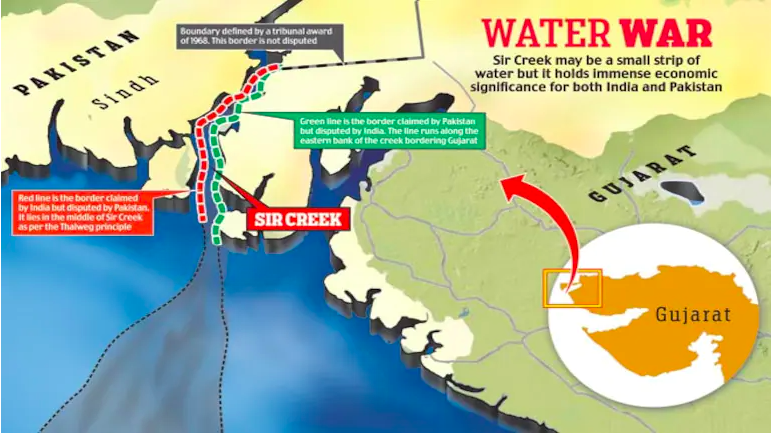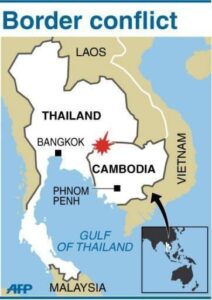The Sir Creek dispute is a border issue between India and Pakistan in the Rann of Kutch, Gujarat, with its roots in colonial-era agreements. Though less contentious than Kashmir, it holds strategic, economic, ecological, and legal significance—making it important for UPSC Prelims, Mains (GS-II: IR), and Essays.
1️⃣ What is Sir Creek?
Length: 96 km strip of water in the marshes of the Rann of Kutch (Gujarat).
Location: Between Kutch (India) and Sindh (Pakistan).
Opens into: Arabian Sea.
Old name: Ban Ganga (renamed Sir Creek during British rule).
2️⃣ What is the Dispute?
Root issue: Different interpretations of the boundary line.
Pakistan’s Position
Based on Bombay Government Resolution, 1914 (agreement between Rao of Kutch & Sindh Government).
Claims entire creek belongs to Pakistan.
Argues the eastern bank (green line) is the boundary.
India’s Position
Refers to 1925 map + 1924 mid-channel pillars.
Claims boundary lies mid-channel (red line).
Cites Thalweg Principle of International Law:
Boundary follows the navigable channel’s midline.
India argues Sir Creek is navigable at high tide (fishing boats pass).
Pakistan’s Counter
Rejects Thalweg principle → says Sir Creek is not navigable.
3️⃣ Origins of the Dispute
1908: Dispute started → collection of firewood in the creek.
1914 Bombay Resolution:
Para 9: Boundary = east bank (supports Pakistan).
Para 10: Boundary = mid-channel (supports India, since creek is navigable).
This contradiction created long-term ambiguity.
4️⃣ Why is Sir Creek Important?
Strategic Importance
Military clashes occurred in 1965 Indo-Pak war.
Maritime boundary influences security in Arabian Sea.
Economic Value
Rich fishing grounds → one of Asia’s largest.
Possible oil & natural gas reserves under the seabed.
Ecological Significance
Wetland habitat for flamingoes and migratory birds.
Part of sensitive Rann of Kutch ecosystem.
Humanitarian Issue
Fishermen often cross unmarked border unknowingly.
Arrests and imprisonment on both sides.
5️⃣ Attempts to Resolve the Issue
1965: British PM Harold Wilson mediated after the war.
Tribunal set up → verdict in 1968 → Pakistan got 10% of its claim.
1997: Composite Dialogue resumed → Sir Creek included.
1999: Tension after Pak Navy aircraft shot down near Sir Creek.
2005–2007: Joint hydrographic surveys carried out.
Current Status:
Issue unresolved.
Considered a “low-hanging fruit” compared to bigger disputes (like Kashmir).
6️⃣ Challenges in Resolution
Legal Ambiguity in 1914 Resolution.
Conflicting interpretations of Thalweg principle.
Distrust between India and Pakistan.
Linkages with larger disputes (Kashmir, terrorism).
7️⃣ Way Forward
Confidence-Building Measures: Release fishermen, joint patrolling.
Bilateral Dialogue: Resume Composite/Backchannel talks.
Joint Resource Sharing: Explore oil, gas, and fishing grounds together.
International Law-Based Solution: Neutral arbitration on Thalweg principle.
Maritime Cooperation: Use dispute resolution to improve Indo-Pak maritime trust.
8️⃣ UPSC Relevance
Prelims
Location-based Qs: Where is Sir Creek?
International Law: Thalweg Principle.
Mains (GS Paper-II)
Discuss the significance of the Sir Creek dispute in India-Pakistan relations.
How does international law apply to the Sir Creek boundary issue?
Essay Paper
“Border disputes in South Asia and their impact on regional peace and development”.
🔑 Key Takeaways
Sir Creek dispute = colonial-era legacy.
Importance lies in security, economy, ecology, and law.
Despite being unresolved, it is easier to settle than other India-Pakistan disputes.
For UPSC, link Sir Creek with India’s maritime security, Indo-Pak relations, and international law.






